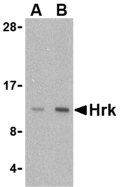Catalog#:3771
Apoptosis plays a major role in normal organism development, tissue homeostasis, and removal of damaged cells. Hrk, a pro-apoptotic member of the Bcl-2 homology domain-3 (BH3)-only group of the Bcl-2 family of proteins, was also identified as novel protein induced during programmed neuronal death. It lacks significant homology to other Bcl-2 family members except for an 8-amino acid region that is similar to the BH3 motif of Bik. Hrk regulates apoptosis through interaction with the anti-apoptotic proteins Bcl-2 and Bcl-XL via this domain. It does not interact with the pro-apoptotic proteins Bax, Bak, or Bcl-XS. Hrk localizes to mitochondrial membranes in a pattern similar to that previously reported for Bcl-2 and Bcl-XL. Despite its predicted molecular weight, Hrk often migrates at 12-15 kDa.
Additional Names: Hrk, Harakiri, Neuronal death proteinDP

Description
Left: Western blot analysis of Hrk in mouse pancreas tissue lysate with Hrk antibody at (A) 2.5 and (B) 5 µg/ml.
Source:HRK antibody was raised against a 15 amino acid peptide from near the center of human Hrk.
Purification: Affinity chromatography purified via peptide column
Clonality and Clone: This is a polyclonal antibody.
Host: Hrk antibody was raised in rabbit.
Please use anti-rabbit secondary antibodies.
Application: Hrk antibody can be used for the detection of Hrk by Western blot at 2.5 - 5 µg/ml.
Tested Application(s): E, WB
Buffer: Antibody is supplied in PBS containing 0.02% sodium azide.
Blocking Peptide:Cat.No. 3771P - Hrk Peptide
Long-Term Storage: Hrk antibody can be stored at 4ºC, stable for one year. As with all antibodies care should be taken to avoid repeated freeze thaw cycles. Antibodies should not be exposed to prolonged high temperatures.
Positive Control:
1. Cat. No. 1414 - Mouse Pancreas Tissue Lysate
Species Reactivity: H, M
GI Number: 4504493
Accession Number: NP_003797
Short Description: a Bcl-2 family member involved durring programmed neuronal death
References
1. Lockshin RA, Osborne B, and Zakeri Z. Cell death in the third millennium. Cell Death Differ. 2000; 7:2-7.
2. Imaizumi K, Tsuda M, Imai Y, et al. Molecular cloning of a novel polypeptide, DP5, induced during programmed neuronal death. J. Biol. Chem. 1997; 272:18842-8.
3. Inohara N, Ding L, Chen S, et al. harakiri, a novel regulator of cell death, encodes a protein that activates apoptosis and interacts selectively with survival-promoting proteins Bcl-2 and Bcl-XL. EMBO J. 1997; 16:1686-94.

No comments:
Post a Comment